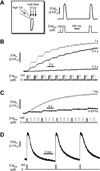Calcium signaling in cardiac mitochondria
- PMID: 23306007
- PMCID: PMC3627826
- DOI: 10.1016/j.yjmcc.2012.12.021
Calcium signaling in cardiac mitochondria
Abstract
Mitochondrial Ca signaling contributes to the regulation of cellular energy metabolism, and mitochondria participate in cardiac excitation-contraction coupling (ECC) through their ability to store Ca, shape the cytosolic Ca signals and generate ATP required for contraction. The mitochondrial inner membrane is equipped with an elaborate system of channels and transporters for Ca uptake and extrusion that allows for the decoding of cytosolic Ca signals, and the storage of Ca in the mitochondrial matrix compartment. Controversy, however remains whether the fast cytosolic Ca transients underlying ECC in the beating heart are transmitted rapidly into the matrix compartment or slowly integrated by the mitochondrial Ca transport machinery. This review summarizes established and novel findings on cardiac mitochondrial Ca transport and buffering, and discusses the evidence either supporting or arguing against the idea that Ca can be taken up rapidly by mitochondria during ECC.
Copyright © 2012 Elsevier Ltd. All rights reserved.
Figures


Similar articles
-
Mitochondrial Ca2+ uptake: tortoise or hare?J Mol Cell Cardiol. 2009 Jun;46(6):767-74. doi: 10.1016/j.yjmcc.2008.12.011. Epub 2008 Dec 31. J Mol Cell Cardiol. 2009. PMID: 19162034 Free PMC article.
-
The mitochondrial calcium uniporter in the heart: energetics and beyond.J Physiol. 2017 Jun 15;595(12):3743-3751. doi: 10.1113/JP273059. Epub 2017 Feb 1. J Physiol. 2017. PMID: 27991671 Free PMC article. Review.
-
A novel mechanism of tandem activation of ryanodine receptors by cytosolic and SR luminal Ca2+ during excitation-contraction coupling in atrial myocytes.J Physiol. 2017 Jun 15;595(12):3835-3845. doi: 10.1113/JP273611. Epub 2017 Feb 1. J Physiol. 2017. PMID: 28028837 Free PMC article.
-
Mitochondrial calcium in heart cells: beat-to-beat oscillations or slow integration of cytosolic transients?J Bioenerg Biomembr. 2000 Feb;32(1):27-33. doi: 10.1023/a:1005556227425. J Bioenerg Biomembr. 2000. PMID: 11768759 Review.
-
Uncoupling protein-2 modulates myocardial excitation-contraction coupling.Circ Res. 2010 Mar 5;106(4):730-8. doi: 10.1161/CIRCRESAHA.109.206631. Epub 2010 Jan 7. Circ Res. 2010. PMID: 20056920
Cited by
-
Pharmacological Modulation of Mitochondrial Ca2+ Content Regulates Sarcoplasmic Reticulum Ca2+ Release via Oxidation of the Ryanodine Receptor by Mitochondria-Derived Reactive Oxygen Species.Front Physiol. 2018 Dec 21;9:1831. doi: 10.3389/fphys.2018.01831. eCollection 2018. Front Physiol. 2018. PMID: 30622478 Free PMC article.
-
Molecular mechanism of mitochondrial calcium uptake.Cell Mol Life Sci. 2015 Apr;72(8):1489-98. doi: 10.1007/s00018-014-1810-1. Epub 2014 Dec 30. Cell Mol Life Sci. 2015. PMID: 25548802 Free PMC article. Review.
-
Mitochondrial mechanosensor in cardiovascular diseases.Vasc Biol. 2020 Jun 22;2(1):R85-R92. doi: 10.1530/VB-20-0002. eCollection 2020. Vasc Biol. 2020. PMID: 32923977 Free PMC article. Review.
-
Pathological Responses of Cardiac Mitochondria to Burn Trauma.Int J Mol Sci. 2020 Sep 11;21(18):6655. doi: 10.3390/ijms21186655. Int J Mol Sci. 2020. PMID: 32932869 Free PMC article. Review.
-
Computational Modeling of In Vitro Swelling of Mitochondria: A Biophysical Approach.Molecules. 2018 Mar 28;23(4):783. doi: 10.3390/molecules23040783. Molecules. 2018. PMID: 29597314 Free PMC article.
References
-
- Bers DM. Cardiac excitation-contraction coupling. Nature. 2002;415:198–205. - PubMed
-
- Huser J, Blatter LA, Sheu SS. Mitochondrial calcium in heart cells: beat-to- beat oscillations or slow integration of cytosolic transients? J Bioenerg Biomembr. 2000;32:27–33. - PubMed
-
- Dedkova EN, Blatter LA. Mitochondrial Ca(2+) and the heart. Cell Calcium. 2008;44:77–91. - PubMed
Publication types
MeSH terms
Substances
Grants and funding
LinkOut - more resources
Full Text Sources
Other Literature Sources

